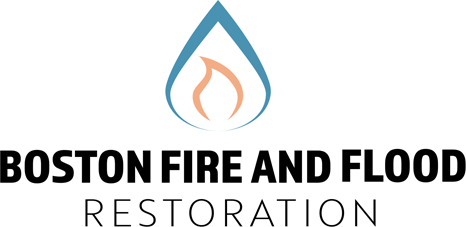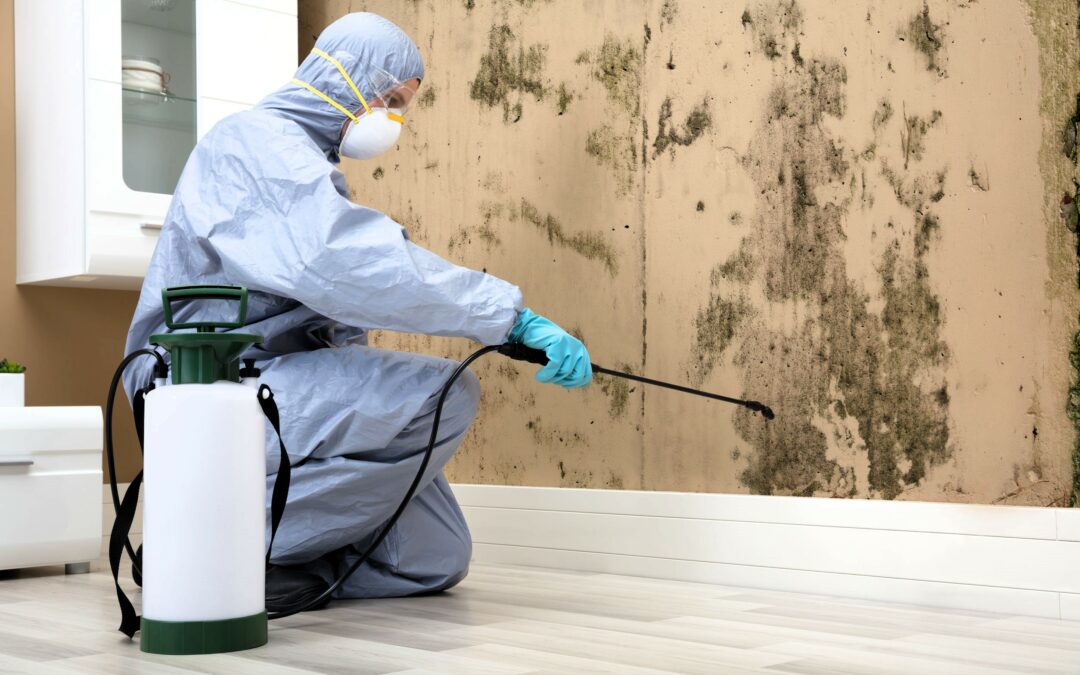When Is Mold Remediation Required? Mold, a silent but pervasive issue in many homes and offices, poses significant risks to both property and health. Often underestimated, its presence can lead to substantial damage and serious health complications. This comprehensive guide delves into the crucial process of mold remediation, emphasizing its importance and detailing when it becomes a necessity. We’ll explore various aspects of mold growth, its impact, and effective strategies for remediation, ensuring a thorough understanding of this vital subject.
Mold remediation, essential for maintaining a healthy living environment, is crucial when mold infestation exceeds 10 square feet or poses health risks, as per the Environmental Protection Agency (EPA) and health experts.

Pest Control Worker In Uniform Spraying Pesticide On Damaged Wall With Sprayer
What Triggers the Need for Mold Remediation?
Mold remediation is a response to several indicators suggesting a severe mold problem. Visible mold patches, persistent musty smells, or health symptoms such as allergies or respiratory issues can signal a growing mold issue. Environmental factors like flooding, ongoing leaks, or high humidity, especially in areas like basements, bathrooms, or kitchens, create ideal conditions for mold proliferation. Understanding these triggers is key to recognizing when professional remediation is necessary to protect both health and property.
The Mold Remediation Process
Professional mold remediation is a multifaceted process that not only removes visible mold but also addresses its underlying causes. This comprehensive approach ensures long-term solutions and involves several key steps:
Initial Assessment and Inspection:
- Conducting a thorough examination of the property to identify visible and hidden mold growth.
- Using tools like moisture meters and infrared cameras to locate the sources of moisture causing mold growth.
- Assessing the extent of the mold infestation and determining the appropriate remediation strategy.
Containment and Isolation:
- Sealing off the affected area to prevent cross-contamination of mold spores to other parts of the building.
- Utilizing physical barriers, like plastic sheeting, and negative air pressure to contain the area.
- Ensuring that HVAC systems are shut off to prevent the spread of spores.
Mold Removal and Cleanup:
- Physically removing mold-infested materials, such as drywall, insulation, or carpeting, when necessary.
- Cleaning surfaces with mold growth using specialized cleaning agents and techniques.
- HEPA vacuuming to capture microscopic mold spores from the air and surfaces.
Air Filtration and Cleaning:
- Employing air scrubbers and HEPA filters to clean and purify the air from mold spores and contaminants.
- Addressing airborne mold to ensure a healthy breathing environment post-remediation.
Treating and Repairing the Source of Moisture:
- Identifying and rectifying the underlying moisture problem that led to mold growth.
- Repairing leaks, improving ventilation, or adjusting humidity levels as required.
Sanitization and Odor Removal:
- Sanitizing affected areas to eliminate any residual mold and bacteria.
- Using deodorization techniques to remove any musty odors associated with mold.
Restoration and Prevention:
- Replacing or repairing damaged materials such as drywall, carpeting, or other building materials.
- Applying mold-resistant paints or primers to prevent future mold growth.
- Providing recommendations for maintaining a mold-free environment, such as controlling humidity and ensuring proper ventilation.
Final Inspection and Verification:
- Conducting a comprehensive final inspection to ensure the complete removal of mold and the effectiveness of remediation efforts.
- Performing air quality tests to confirm that mold spore counts have returned to safe levels.
Costs and Considerations in Mold Remediation
The financial aspect of mold remediation is a common concern. As of 2024, costs can range from $1,100 to $3,300, influenced by factors such as the mold’s location, infestation size, and necessary repairs. Some homeowners’ insurance policies may cover these costs, but this varies, and early detection is key to managing expenses. The investment in professional remediation is invaluable when considering the potential costs of unchecked mold growth, including extensive property damage and health risks.
Signs You May Need a Mold Remediation Professional
Recognizing when to seek professional mold remediation is crucial for maintaining the health and safety of your living environment. Here are key indicators that suggest it’s time to call in the experts:
Visible Mold Growth: One of the most obvious signs is the presence of mold itself. Mold can appear in various colors such as black, green, white, or even orange and pink. It may look like speckles, fuzzy spots, or filmy patches on surfaces. Common areas to spot visible mold include damp or humid spaces like bathrooms, basements, under sinks, and around windows.
Persistent Musty Odors: Mold often produces a distinct musty, earthy smell, similar to the scent of wet socks or rotten wood. If you notice such odors that come and go or seem concentrated in certain areas of your home, it could indicate hidden mold growth behind walls or under floors.
History of Water Problems: Homes that have experienced flooding, leaks, or have chronic condensation issues are at a higher risk for mold growth. If your house has had any water-related issues, it’s advisable to get a mold inspection, as mold can develop in as little as 24-48 hours in wet conditions.
Health Symptoms: Exposure to mold can lead to various health issues, especially in individuals with mold sensitivities or allergies. Symptoms like wheezing, red eyes, stuffy nose, and skin irritation can be signs of mold exposure. If these symptoms are persistent in your home and seem to lessen when you are away, it could be due to mold.
Deterioration of Household Materials: Mold can cause damage to building materials. If you notice paint peeling, wallpaper coming loose, or warping in your woodwork, these could be signs of underlying mold problems caused by excess moisture.
Excessive Humidity: High humidity levels in your home can lead to condensation and mold growth. If your windows often have condensation or there are damp spots on walls or ceilings, these could be precursors to mold problems.
Discoloration on Surfaces: Often, mold begins as a slight discoloration that homeowners might overlook. Any unusual staining or color changes on walls, ceilings, or floors should be investigated as potential signs of mold growth.
Air Quality Concerns: If the indoor air quality in your home seems to have deteriorated, or if there’s an increase in dust and particulate matter, it could be due to mold spores circulating in the air.
Remember, if you suspect mold in your home, it’s always better to consult with a mold remediation professional. They can accurately diagnose the presence of mold and recommend the appropriate course of action to ensure your home is safe and healthy.
Preventative Measures to Avoid Mold Problems
Prevention is the most effective strategy against mold. The EPA advises maintaining indoor humidity below 50%, using dehumidifiers, and ensuring good ventilation to deter mold growth. Regular home inspections, particularly in areas prone to moisture, are crucial. Promptly addressing leaks and using mold-resistant materials in construction can also significantly reduce the likelihood of mold problems. These preventive measures are essential in any comprehensive approach to mold management.
Conclusion:
Timely and effective mold remediation is paramount in preserving a healthy living environment. It goes beyond mere removal, targeting the root causes of mold growth to provide a long-lasting solution. Homeowners should prioritize regular inspections and swift action upon the first signs of mold, ensuring their living spaces remain safe and mold-free.
FAQ Section When Is Mold Remediation Required
When is Professional Mold Remediation Absolutely Necessary?
Professional remediation is crucial when mold covers an area larger than 10 square feet, when there’s extensive water damage, or when mold causes health issues. EPA guidelines stress the importance of professional assessment and remediation in such scenarios to prevent further spread and health risks.
How Can I Identify Mold Problems Before They Worsen?
Early detection of mold involves looking for visible signs like discoloration, sensing musty odors, or noticing health symptoms related to mold exposure. Regular inspections, especially in prone areas like basements and bathrooms, can help catch mold growth early.
What Are the Long-Term Effects of Neglecting Mold Remediation?
Ignoring mold can lead to significant property damage, including rotting wood and compromised structural integrity. Health-wise, prolonged exposure can cause respiratory issues, allergies, and other serious health problems, particularly in vulnerable individuals.
Is Mold Remediation Covered by Home Insurance Policies?
Some home insurance policies cover mold remediation, but this varies. It’s important to check with your insurance provider to understand the specifics of your coverage regarding mold damage and remediation.
Can I Perform Mold Remediation Myself, and When Should I Avoid It?
While small mold problems can sometimes be addressed by homeowners, large infestations require professional remediation. DIY efforts in severe cases can exacerbate the problem and pose health risks. It’s advisable to consult professionals for substantial mold issues.


